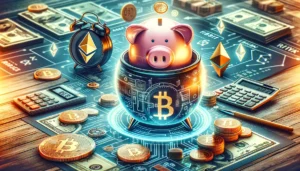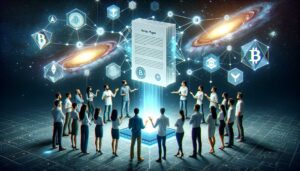In recent times, the buzzword “What are NFT coins?” has echoed through the digital realms, stirring curiosity and excitement alike. These unique digital assets, known as Non-Fungible Tokens (NFTs), have taken the digital world by storm, crafting a niche of value in the ephemeral. As you delve into this article, prepare to journey through the digital tapestry of NFTs, unraveling their essence and their impact on the digital economy.
Quick Takes
| Section | Key Takeaway |
| Definition of NFTs | NFTs are unique digital assets verified through blockchain technology. |
| Technical Underpinnings | Most NFTs are built on Ethereum’s blockchain using specific standards. |
| Usage of NFTs | NFTs find applications in digital art, music, and virtual real estate among others. |
| Economic Impact | NFTs have created a new marketplace for digital assets with notable sales. |
| Legal and Ethical Considerations | NFTs bring about legal and ethical discussions, particularly in copyright law. |
| The Future of NFTs | NFTs have a promising future with potential for mainstream adoption and new use cases. |
Embark on this enlightening expedition into the world of NFT coins, and emerge with a treasure trove of knowledge that could reshape your digital perspective!
Definition of NFTs
What are NFTs?
Non-Fungible Tokens (NFTs) are distinct digital assets representing ownership or proof of authenticity of a unique item or piece of content, like artwork, collectibles, or even tweets. Unlike cryptocurrencies such as Bitcoin or Ethereum, which are interchangeable and identical to each other, each NFT is unique and cannot be exchanged on a one-to-one basis with any other token.
Uniqueness and Indivisibility
- Uniqueness: Each NFT carries metadata that distinguishes it from any other, and this information is stored on a blockchain, ensuring its authenticity and ownership.
- Indivisibility: NFTs cannot be divided into smaller units and sold. You buy the whole item or none at all.
| Fungible Tokens | Non-Fungible Tokens |
| Identical in value | Unique |
| Interchangeable with other tokens of the same type | Cannot be exchanged for other tokens |
| Examples include cryptocurrencies like Bitcoin and Ethereum | Examples include collectibles like CryptoKitties and NBA Top Shot moments |
Real-World Analogies
To grasp the essence of NFTs, think of them as digital certificates of authenticity. For instance:
- A signed baseball card
- An autographed manuscript
- A first-edition book
These items hold unique value, much like NFTs in the digital realm.
Relevance to Digital Assets
NFTs have breathed new life into digital assets, providing a mechanism to prove ownership and provenance. Through NFTs, digital assets can now be bought, sold, or held just like traditional assets. They’ve become particularly popular in the art world, as they allow artists to monetize their work in new ways. Explore the allure of NFTs further in this deep dive.
Through the definition and characteristics of NFTs, we embark on a journey to understand their economic impact, usage, and the legal landscape surrounding them in the following sections.
Technical Underpinnings
Blockchain Technology
NFTs are built on blockchain technology, which ensures the verifiability and ownership of these digital assets. Blockchain’s decentralized and immutable nature forms the backbone of NFTs, safeguarding the information against alteration.
Standards for Creating NFTs
- ERC-721: The pioneer standard for creating unique tokens with distinct values.
- ERC-1155: A more flexible standard allowing for both fungible and non-fungible tokens.
Minting Process
Minting is the process of creating a new NFT. It involves uploading a digital file to a marketplace, which then gets assigned a unique identifier and is added to the blockchain. Dive deeper into the financial aspect of creating NFTs in this guide on how much it costs to create an NFT.
Understanding the technical foundations of NFTs unveils the mechanism that underpins their uniqueness and ownership, setting the stage for exploring the vast applications of NFTs in the digital realm.
Usage of NFTs
Digital Art and Collectibles
NFTs have revolutionized the way we perceive and trade digital art and collectibles. They provide a digital certificate of ownership that can be bought or sold. Learn more about turning digital art into real money in this comprehensive guide.

The myriad applications of NFTs extend beyond digital art, venturing into realms like virtual real estate, gaming, and much more. As we continue, we’ll delve into the economic impact this innovation has in the digital and traditional marketplaces.
Economic Impact
Financial Revolution
NFTs are not just digital assets; they are at the forefront of a financial revolution. By tokenizing digital art and other assets, NFTs have created a new marketplace. Explore the financial potential of NFTs in this article.
Notable Sales
- Beeple’s artwork sale for $69 million.
- NBA Top Shot moments.
- Jack Dorsey’s first tweet.
These sales highlight the financial impact and the potential for high-value transactions within the NFT market, portraying a promising economic outlook for digital creators and investors.
Legal and Ethical Considerations
Copyright and Ownership
Navigating the legal landscape of NFTs, particularly around copyright and ownership, requires a nuanced understanding. Delve deeper into the regulatory compass of NFTs in this comprehensive guide.
Ethical Considerations
- Digital ownership vs physical ownership.
- Environmental impact of blockchain technology.
- The potential for market manipulation.
The legal and ethical maze surrounding NFTs adds a layer of complexity to their adoption and acceptance, yet also provides a realm for discourse and evolution.
The Future of NFTs
Potential Future Uses
- Virtual Real Estate
- Gaming Assets
- Identity Verification
Mainstream Adoption
The horizon is promising for NFTs with potential mainstream adoption. Artists, creators, and enterprises are increasingly exploring NFTs, opening new avenues for digital ownership.
Final Thoughts
The journey of NFTs is just beginning, and the endless possibilities they offer are yet to be fully explored. Discover more about the allure of NFTs in this insightful article. The unfolding narrative of NFTs is a saga of innovation, poised to redefine digital ownership in a blockchain-driven era.
Unveiling Digital Authenticity
As we venture through the cryptic yet fascinating realm of NFTs, the prospects of digital ownership unfold before us. The tapestry of NFTs is not merely a transient digital fad but a harbinger of a new era where digital assets hold tangible value, authenticated by blockchain’s indelible imprint. The journey we embarked on elucidates the essence, the potential, and the challenges that encompass the NFT realm. With each digital stride, we edge closer to a future where the digital and tangible entwine, heralding an era of digital authenticity. So, as the digital horizon expands, the saga of NFTs continues to unravel, beckoning us to explore further.
Frequently Asked Questions
| Question | Answer |
| What are NFTs? | Non-Fungible Tokens (NFTs) are unique digital assets verified on a blockchain. |
| How are NFTs created? | NFTs are minted on blockchain platforms using specific standards like ERC-721 or ERC-1155. |
| Where can I buy or sell NFTs? | NFTs can be traded on various online platforms like OpenSea, Rarible, or NBA Top Shot. |
| What is the significance of NFTs? | NFTs provide a way to prove ownership and authenticity of unique digital items. |
| Can NFTs be divided? | No, NFTs are indivisible; they are sold as a whole item. |
| How do NFTs relate to blockchain? | NFTs are stored on a blockchain which verifies their uniqueness and ownership. |




